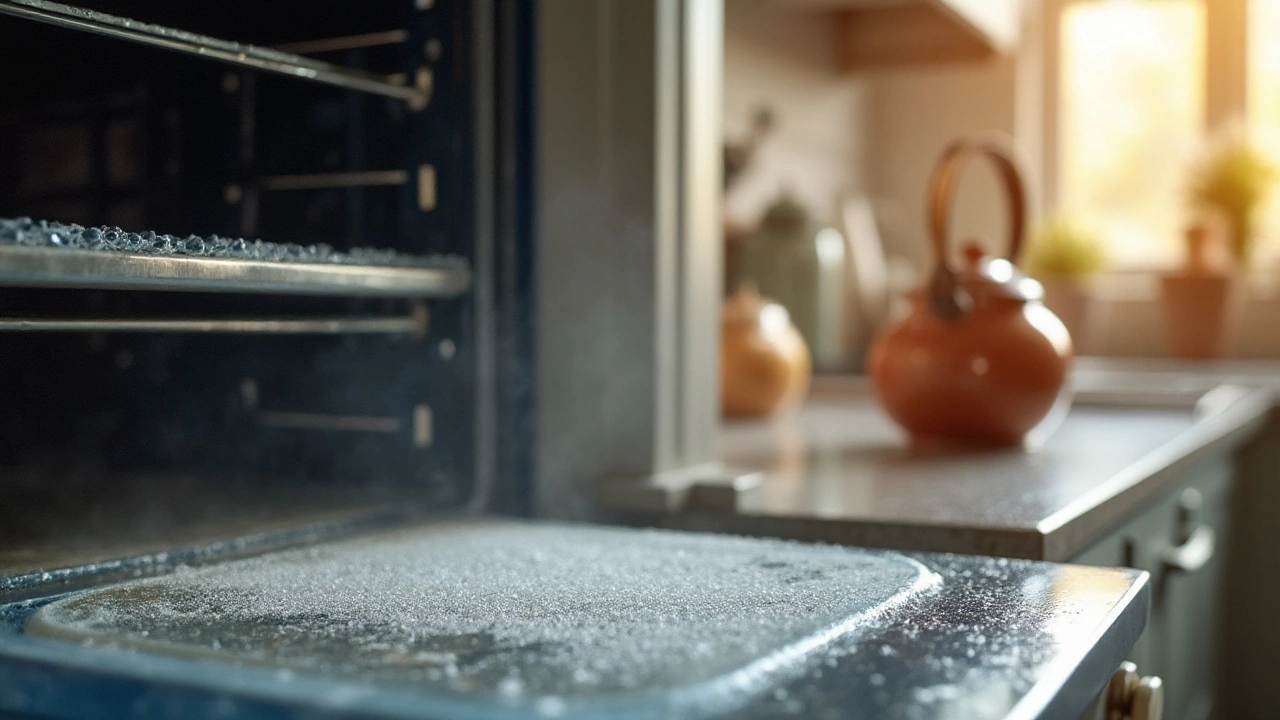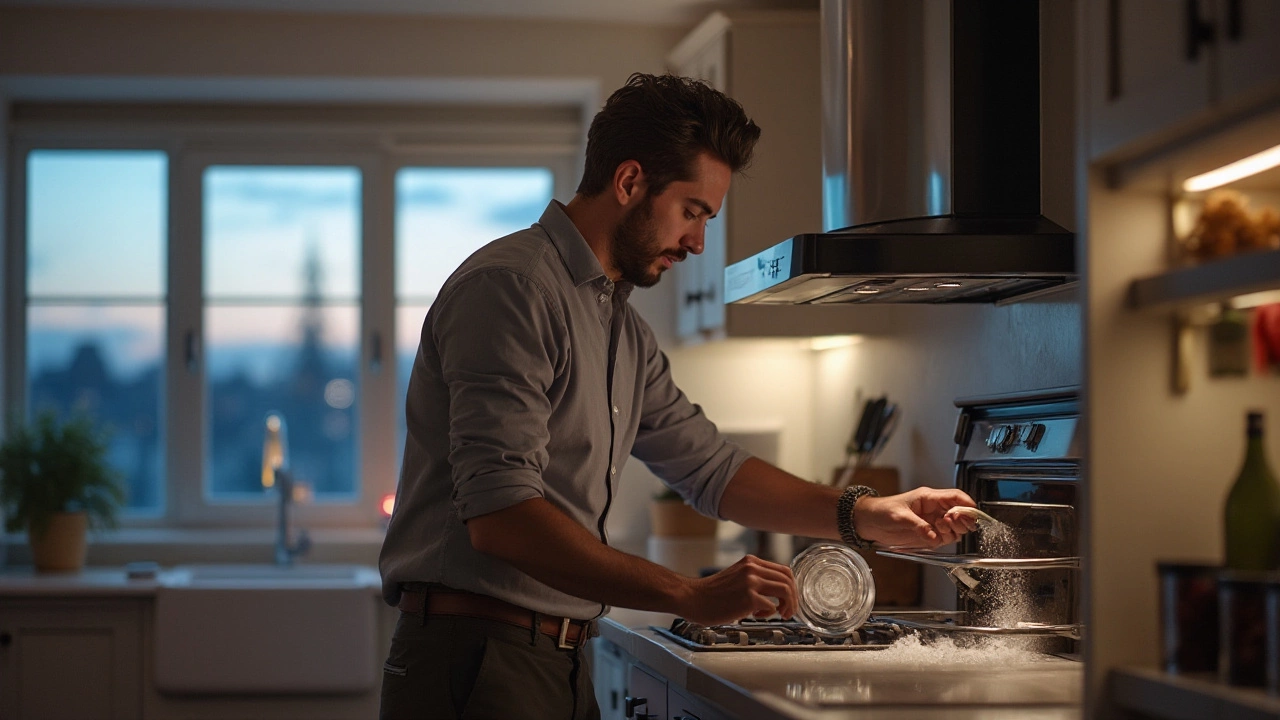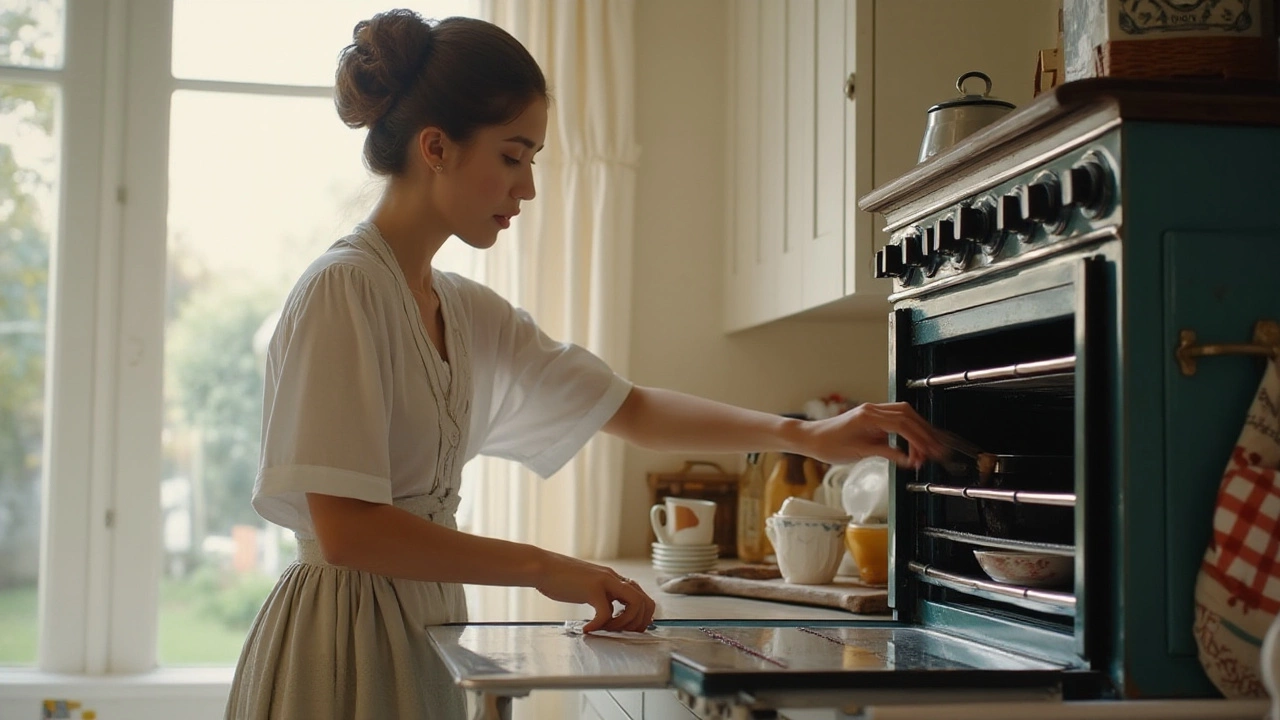Cleaning the oven isn’t exactly the highlight of kitchen chores, but it’s one of those necessary evils for a hygienic cooking space. What if I told you there’s a way to tackle this task without amorphous chemical scents wafting through your home? Enter baking soda and vinegar, a duo of ingredients you probably already have in your pantry, ready to make your oven gleam without fuss.
For generations, these humble kitchen staples have been revered not just for culinary purposes but also for their remarkable cleaning prowess. By understanding how these two work together, you can unleash their full power and transform your oven cleaning routine into something far less daunting.
Yet, not all that bubbles may work the same; knowing how long to let these ingredients work their magic could be the game changer you need. Let’s dive into the bubbling science and efficient cleaning strategy to bring back your oven’s shine.
- Understanding the Chemistry of Baking Soda and Vinegar
- Preparing Your Oven for Cleaning
- Step-by-Step Cleaning Process
- Safety Tips and Tricks
- Additional Tips for Maintaining a Clean Oven
Understanding the Chemistry of Baking Soda and Vinegar
When it comes to cleaning, the combination of baking soda and vinegar is nothing short of a kitchen miracle. This dynamic duo has been a trusted ally in households for generations, known for their ability to tackle tough stains and grime. But what about these two common ingredients makes them so effective for oven cleaning? To understand this, we must delve into the chemistry that powers their cleaning capabilities. Baking soda, or sodium bicarbonate, is a mild alkali. This characteristic makes it great at neutralizing acids and breaking down the oily, fatty substances that commonly coat the interior of ovens. Vinegar, on the other hand, is acetic acid, a household staple with a tangy scent that can break down mineral deposits and cut through grime. When these two ingredients come into contact, a chemical reaction occurs, producing carbon dioxide gas and water, which helps lift dirt and grime away from surfaces.
This bubbling action is the key to their cleaning power— it physically helps loosen burnt-on food particles and oily residue stuck on the oven walls and racks. The fizzing effect can also act as a gentle abrasive, working away stubborn spots without scratching the surface of the oven. According to the American Cleaning Institute, "The reaction helps loosen the particles, making them easier to wipe away."
The National Science Foundation elaborates, stating that "the combination of baking soda and vinegar can increase cleaning efficiency, as their pH difference maximizes the lift of undesirable material."But it’s not just about the fizz and bubble; the individual properties of each ingredient play a crucial role. Baking soda’s gentle scrubbing power combines effectively with vinegar’s ability to thwart bacteria and mold, resulting in an efficient and eco-friendly cleaner. This harmonious balance of chemistry not only cleans but also sanitizes, leaving your oven safe for your next culinary creation.
A fascinating aspect of this combination is its non-toxicity, making it a preferred choice for households conscious of minimizing chemical exposure. Besides being friendly to the environment, they pose no health risks associated with inhaling or touching hazardous cleaners. The simplicity and accessibility of these ingredients further their appeal, as most homes already stock them for cooking purposes. It’s a cleaning strategy that carries through generations, whispered from grandmother’s wisdom to modern savvy homemakers. But effectiveness is not purely theoretical; hands-on testimonials abound on cleaning forums and social media, with countless snapshots of sparkling ovens as evidence. While this combo is a cleaning hero, it’s essential to utilize it properly to reap the full benefits. Managing the proportions and letting the mixture sit for the right amount of time ensures the complete disintegration of stubborn build-ups. Understanding these nuances can transform your approach to oven cleaning, making it not just a chore, but a vastly satisfying activity.
Preparing Your Oven for Cleaning
Before diving into the cleaning process with baking soda and vinegar, a little bit of groundwork is necessary to ensure that your efforts pay off big time. The first step in preparing your oven for cleaning hinges on safety. Begin by unplugging your oven if it's electric or ensuring the gas is off if it's gas-powered. This simple precaution goes a long way in preventing any mishaps. With the power source handled, remove oven racks and other removable parts, placing them aside for separate cleaning. These parts can often hold as much grime as the oven itself, and giving them individual attention ensures a thorough clean. Remember, these racks can be soaked in a tub of warm, soapy water, giving the grime some softening time before you tackle it head-on.
With an empty oven, take a moment to brush away loose debris, crumbs, and any burned residues lurking in the corners. A simple handheld vacuum or a soft brush can be incredibly useful here, helping you start the actual cleaning with a somewhat clean slate. Achieving success in cleaning often starts with reducing the mess you need to contend with. With these loose bits and pieces out of the way, your oven cleaning will be much more effective and far less frustrating.
Once you've cleared the debris and removed the racks, it's time to craft your cleaning solution. In a bowl, mix about half a cup of baking soda with a few tablespoons of water, adjusting the ratio until you achieve a paste-like consistency. This paste is at the core of a DIY cleaning solution renowned for its ability to tackle stubborn residue without scratching surfaces. Spread this paste all over the oven's interior using a spatula or soft brush, paying special attention to the nooks and crannies. Let this coat sit overnight. This waiting period is crucial, allowing the baking soda to work its magic without interference. The magic happens over time, as the baking soda breaks down grime and residue, making them easier to wipe away the next day.
“Having patience with these steps can truly alter the outcome,” notes Mimi Kirk, a renowned author on sustainable living.
It’s about letting nature do its work overnight so, come morning, you’re left with less elbow grease to exert.With the baking soda paste working diligently overnight, you'll later use vinegar to tackle any remaining spots, making it a partner rather than a standalone miracle worker. Now, with the preparation stage complete, you're primed for the main event. This attentive and detailed preparatory step ensures the oven cleaning process is not just effective, it also transitions into an almost effortless task by the time you reach the last step.

Step-by-Step Cleaning Process
The excitement of turning your oven from grimy to gleaming often begins with a correct mix of baking soda and water. You'll create a paste that’s easy to handle and liberally coat the interior of your oven without any headache. This process starts by removing any oven racks; don't worry, they can be cleaned separately with the same concoction. In a bowl, combine half a cup of baking soda with a few spoonfuls of water. Adjust until you have a paste that’s spreadable, not runny. Spreading this mixture is a bit like painting; it shouldn't be a meticulous affair. Pay special attention to areas heavily burdened with grease and grime. Applying the paste generously will ensure its contact cleans what remains stubbornly stuck.
The secret to this process doesn't stop at application. The paste needs time to break down the gunk. Allow the mix to sit overnight, which gives the baking soda enough time to work its magic on tough stains and residues. While it's at work, the chemical reaction between the baking soda and grease loosens the stubborn particles. It’s a transformation happening right under your nose. Some folks wonder, “Why overnight?” Well, the truth is, the longer the paste remains, the less elbow grease you'll need come morning, and who doesn't like the sound of that?
Now comes the starring role of vinegar. While baking soda's power is indisputable, its interaction with vinegar elevates the cleaning process. Using a spray bottle filled with vinegar, douse all the dried surfaces of the baking soda paste. Wondering what happens next? You’ll hear a satisfying fizzing sound, and bubbles will form. This illustrates the reaction working diligently to lift grime away. Don't fret if some areas start to bubble vigorously; that’s the power of a natural cleaning solution at play. Vinegar neutralizes odors too, leaving the oven fresh.
Once the fizzing subsides, it’s time for the sweat-free effort in the process — wiping everything down. Armed with a damp cloth, start to remove the remnants of the paste and the gritty stains it has encased. For those extra pesky spots, you might need to give it a little more encouragement with a scrubber, but remember, much of the hard work happened overnight. Once cleaned, perhaps you'll be delighted to find zero traces of both grime and cleaning agents. You don't want any surprises the next time you cook a meal.
Some wonder whether these homemade cleaning solutions prove their mettle compared to commercial alternatives. Trust in their efficacy has grown significantly; as a recent survey suggested, 78% of households using them reported satisfaction largely due to their non-toxic nature and low cost. Of course, the process does not provide an instant change, yet the brilliance and satisfaction experienced post-cleaning are unmatched.
Safety Tips and Tricks
When it comes to using baking soda and vinegar for oven cleaning, safety should always take center stage. Many of us love the idea of eliminating chemicals from our lives, opting for natural solutions. But just because something is natural doesn’t mean we can overlook the importance of safety. Although baking soda and vinegar are kitchen staples, they deserve our respect during the cleaning process.
Let’s remember that the fizzing and bubbling reaction between baking soda and vinegar, while effective at cleaning, can be quite vigorous. This reaction produces carbon dioxide, which is generally harmless. However, it’s wise to ensure that the area is well-ventilated to avoid breathing in the fizz if you’re using a large amount at once. Open a window or turn on an exhaust fan to circulate fresh air, reducing any potential discomfort from the reaction fumes.
Before you start splattering your oven with this duo, remember to remove the oven racks. This not only allows for thorough cleaning but also prevents the solution from pooling at the bottom of the oven, which could lead to not just a mess but safety hazards if it seeps into places it shouldn't. A gentle reminder: wear gloves. Though baking soda is mild and vinegar safe, your skin might not appreciate prolonged exposure, leading to dryness or minor irritation. As they say in the safety world, prevention is better than cure.
Apart from personal protection, safeguard your kitchen. Cover any sensitive surfaces nearby to ensure that splashes during cleaning don't accidentally damage them. A sturdy plastic sheet or a couple of layers of newspaper will do the trick. And although we're all for natural options, stay clear of mixing vinegar or baking soda with other cleaners. Strange as it might seem, combining multiple cleaning solutions can lead to chemical reactions that could be downright dangerous.
“The best advice is to always test your cleaning solution on a small, inconspicuous area first,” says kitchen expert, Rachel Garwood. “This simple step could save you from unwanted surprises like discoloration or damage.”
Those looking to tackle the entire kitchen with DIY cleaning solutions should delve into research regarding combinations that are safe, and those that are not. Certain substances simply don’t play nice with others. Trust us, it’s better to double-check and be safe than sorry on this front.
Once the cleaning frenzy is over and your oven sparkles once more, properly store your baking soda and vinegar. Keeping them in a cool, dry place prevents clumping and degradation. These pantry staples, like all good things, last longer when cared for, ensuring they’re ready for your next cleaning endeavor or baking spree.

Additional Tips for Maintaining a Clean Oven
Regular maintenance of your oven can save you from the daunting task of deep cleaning every so often. A clean oven not only looks good, but it also improves efficiency and extends the appliance's lifespan. Let's delve into some detailed tips to keep your oven in top-notch condition all year round. One vital thing to consider is regular attention. Instead of letting the grime and grease build up until you have to spend an entire day scrubbing it away, incorporate a light cleaning routine into your monthly chores. After cooking, make it a habit to wipe down surfaces with a damp cloth while the oven is still slightly warm—this prevents particles from baking onto the surface and turning into stubborn stains.
Another tip is to be proactive with spills. Anytime your roast or casserole bubbles over, sprinkle a generous amount of baking soda over the affected area to absorb the moisture and neutralize odors. Later, when the oven cools, a wipe with vinegar will lift the remnants without difficulty. Implementing drip trays or baking sheets under your dishes can also catch spills before they become a problem. To enhance the cleanliness of accessible machine parts like racks, remove them periodically and soak in warm, soapy water to remove accumulated grimness.
If you're a fan of oven-baked proteins, consider marinating your meat in enclosed cookware to minimize oil splatters during cooking. Some people swear by keeping an open bowl of water and vinegar near the bottom rack while cooking. This mixture ensures moisture in the oven, which can help silently clean the walls by loosening any dried-on grime as you bake your next gourmet meal. Plus, it acts as a natural deodorizer, combating any lingering smells from your newest culinary adventure.
According to an article in Good Housekeeping, "An ounce of prevention truly pays off in the kitchen, most notably when it comes to keeping stubborn oils and residues at bay."
Those who often find themselves forgetting to clean the oven despite the best intentions might benefit from setting reminders on their digital calendars or employing stove-cleaning friendly gadgets that work similarly to a robotic vacuum. Lastly, occasional professional servicing may not be a bad idea—especially if past the warranty—where a technician can evaluate the appliance’s condition, providing peace of mind regarding its health. These savvy practices will empower you not only to maintain an impressively clean oven but also set a standard for cleanliness that resonates throughout your cooking space.
